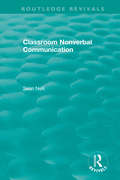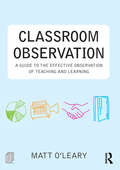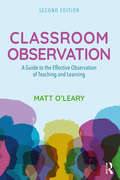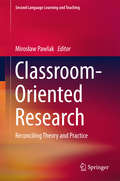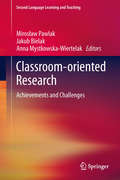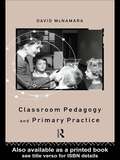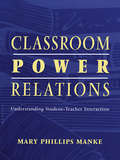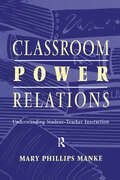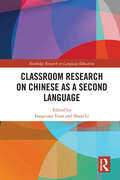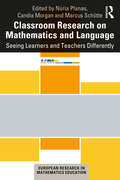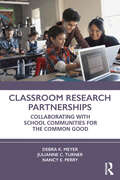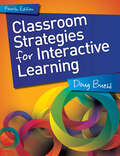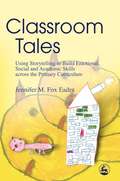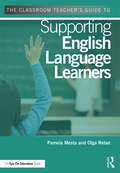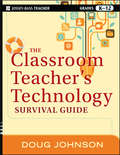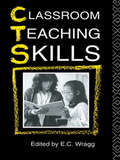- Table View
- List View
Classroom Nonverbal Communication (Routledge Revivals)
by Sean NeillNonverbal signals are less easily controlled that words and thus, potentially, offer reliable information to both teachers and children on each other’s true intentions. But such signals are also more ambiguous than words, and this makes them valuable when teachers or children wish to send a message they do not want to be challenged. Even so, misunderstandings can occur, for example, between different ethnic groups. Originally published in 1991, Sean Neill explores how children’s skill in using and understanding nonverbal signals increases with age. The appropriate nonverbal signals for teachers differ from those used in informal conversation because of the teacher’s controlling, instructing and encouraging role, and this creates problems for new teachers, who also find it difficult to interpret the limited feedback from the class. A detailed coverage of teachers’ and children’s signals leads on to a survey of how teachers acquire nonverbal skills and research on effective training. Classroom Nonverbal Communication provides the only comprehensive survey of these areas for staff involved in the initial and in-service training of teachers, and in staff development. Classroom social arrangements are permanently reflected in seating layout and room design, which can allow teachers and administrators to influence classroom interaction through advance planning. For these groups, this richly illustrated volume assesses how effective such planning really is. Sean Neill has researched room layout and nonverbal communication in education since 1975 and has published many papers dealing with these issues. He provides a uniquely comprehensive survey of the research evidence on classroom nonverbal communication.
Classroom Observation: A guide to the effective observation of teaching and learning
by Matt O'LearyClassroom Observation explores the pivotal role of lesson observation in the training, assessment and development of new and experienced teachers. Offering practical guidance and detailed insight on an aspect of training that is a source of anxiety for many teachers, this thought-provoking book offers a critical analysis of the place, role and nature of lesson observation in the lives of education professionals. Illustrated throughout with practical examples from a range of education settings, it considers observation as a means of assessing teaching and learning and also as a way of developing teachers’ skills and knowledge. Key topics include: The purposes and uses of lesson observation The socio-political and historical context in which lesson observation has developed Practical guidance on a range of observation models and methods Teacher autonomy and professional identity Performance management, professional standards and accountability Peer observation, self-observation and critical reflection Using video in lesson observation. Written for all student and practising teachers as well teacher educators and those engaged in educational research, Classroom Observation is an essential introduction to how we observe, why we observe and how it can be best used to improve teaching and learning.
Classroom Observation: A guide to the effective observation of teaching and learning
by Matt O'LearyClassroom Observation explores the pivotal role of lesson observation in the training, assessment and development of new and experienced teachers. Offering practical guidance and detailed insight on an aspect of training that is a source of anxiety for many teachers, this thought-provoking book offers a critical analysis of the place, role and nature of lesson observation in the lives of education professionals. Illustrated throughout with practical examples from a range of education settings, it considers observation as a means of assessing teaching and learning and also as a way of developing teachers’ skills and knowledge. Key topics include: The purposes and uses of lesson observation The socio-political and historical context in which lesson observation has developed Practical guidance on a range of observation models and methods Teacher autonomy and professional identity Performance management, professional standards and accountability Peer observation, self-observation and critical reflection Using video in lesson observation. Written for all student and practising teachers as well teacher educators and those engaged in educational research, Classroom Observation is an essential introduction to how we observe, why we observe and how it can be best used to improve teaching and learning.
Classroom Observation: A Guide to the Effective Observation of Teaching and Learning
by Matt O'LearyBuilding on recent changes and debates surrounding the use of observation, this fully updated second edition of Classroom Observation explores the role of lesson observation in the preparation, assessment and professional learning of teachers, lecturers and educators at all levels and across all educational organisations. Offering practical guidance and detailed insights on an aspect of training that is a source of anxiety for many teachers, this thought-provoking book offers a critical analysis of the place, role and nature of lesson observation in the lives of education professionals. Updated to incorporate the latest research, policy and practical developments on observation, this new edition also includes greater coverage of research and developments in the field of observation beyond the UK. Enabling readers to use observation as a lens for understanding, informing and improving teaching and learning, and equipping them with structured frameworks for applying observation, this book includes sections on: Teacher autonomy and professional identity Performance management, professional standards and accountability Peer observation, self-observation and critical reflection Educational assessment and evaluation Peer-based models of observation Using digital technology to inform learning. Written for all student and practising teachers as well as teacher educators and those engaged in educational research, Classroom Observation is an essential introduction to how we observe, why we observe, and how it can be best used to improve teaching and learning.
Classroom Observation: A Guide to the Effective Observation of Teaching and Learning
by Matt O'LearyBuilding on recent changes and debates surrounding the use of observation, this fully updated second edition of Classroom Observation explores the role of lesson observation in the preparation, assessment and professional learning of teachers, lecturers and educators at all levels and across all educational organisations. Offering practical guidance and detailed insights on an aspect of training that is a source of anxiety for many teachers, this thought-provoking book offers a critical analysis of the place, role and nature of lesson observation in the lives of education professionals. Updated to incorporate the latest research, policy and practical developments on observation, this new edition also includes greater coverage of research and developments in the field of observation beyond the UK. Enabling readers to use observation as a lens for understanding, informing and improving teaching and learning, and equipping them with structured frameworks for applying observation, this book includes sections on: Teacher autonomy and professional identity Performance management, professional standards and accountability Peer observation, self-observation and critical reflection Educational assessment and evaluation Peer-based models of observation Using digital technology to inform learning. Written for all student and practising teachers as well as teacher educators and those engaged in educational research, Classroom Observation is an essential introduction to how we observe, why we observe, and how it can be best used to improve teaching and learning.
Classroom-Oriented Research: Reconciling Theory and Practice (Second Language Learning and Teaching)
by Mirosław PawlakThis collection gathers contributions from scholars from Poland and abroad addressing different facets of research into the processes of foreign-language and second-language learning and teaching as they transpire in a typical language classroom. The book is divided into three parts, which address in turn: research directions and methodology, the findings of empirical research, and links between theoretical considerations and classroom practice. Accordingly, the first part includes papers that examine the role of different research paradigms, put forward concrete research proposals, present innovative data gathering tools or assess the role of such instruments in language teaching. The second part includes reports on original research studies focusing e.g. on teachers’ beliefs, the role of lexis and pragmatics, the application of modern technologies, the teaching and assessment of primary school children, and the development of social skills from a cross-cultural perspective. Finally, the third part of the book demonstrates how theory-driven approaches can enhance the effectiveness of instructed second language acquisition.
Classroom-oriented Research: Achievements and Challenges (Second Language Learning and Teaching)
by Mirosław Pawlak Jakub Bielak Anna Mystkowska-WiertelakThe volume brings together papers related to different aspects of classroom-oriented research on teaching and learning second and foreign languages that have been authored by specialists from Poland and abroad. The first part contains contributions dealing with individual variation in the language classroom, in particular age, anxiety, beliefs and language learning strategies. The second part deals with various facets of teachers’ behaviors in the classroom, focusing in particular on classroom communication and the use of action research in teacher training. The third part includes papers devoted to various instructional practices, such as the use of new technologies, the development of intercultural competence, assessment or combining content and language. Finally, the last part deals with issues involved in research methodology, with special emphasis being placed on the use of diaries, observations, mixed methods research as well as triangulation.
Classroom Pedagogy and Primary Practice
by David McNamara Professor David McnamaraIn this provocative book, David McNamara argues that a `teacher-centred' approch to teaching in the primary school, especially in the later years is actually in the best interests of the children - that the teacher must be seen to have ultimate responsibility for what and how children learn. He attempts to define the distinctive professional expertise of the primary teacher - the application of subject knowledge within the special circumstances of the classroom - and to show how this expertise can be articulated to establish a body of educational knowledge which is both derived from practice and practically useful to others.At a time when increasing emphasis is being placed on the role of the practising teacher as a mentor in intitial teacher education, this book will help teachers at all levels to define their own role in the creation of educational knowledge.
Classroom Pedagogy and Primary Practice
by David McNamara Professor David McnamaraIn this provocative book, David McNamara argues that a `teacher-centred' approch to teaching in the primary school, especially in the later years is actually in the best interests of the children - that the teacher must be seen to have ultimate responsibility for what and how children learn. He attempts to define the distinctive professional expertise of the primary teacher - the application of subject knowledge within the special circumstances of the classroom - and to show how this expertise can be articulated to establish a body of educational knowledge which is both derived from practice and practically useful to others.At a time when increasing emphasis is being placed on the role of the practising teacher as a mentor in intitial teacher education, this book will help teachers at all levels to define their own role in the creation of educational knowledge.
Classroom Power Relations: Understanding Student-teacher Interaction
by Mary MankeThis book is based on a careful theorizing of classroom power relations that sees them as constructed from the actions of all participants. Contrary to the common assumption that the teacher is the source of classroom power, it sees that power as arising from the interaction between students and teachers. If power is owned by the teacher, she is completely responsible for events in the classroom, whether or not she chooses to share her power/control/authority with the students. If, as this book claims, power is the joint creation of all participants, teachers are freed from an excessive and damaging weight of responsibility for classroom events and outcomes. The shared responsibility between students and teachers for what happens in the classroom is brought to light. Based on an ethnographic study of three elementary classrooms, this book offers a careful look at the workings of classroom power. It is of interest both to those seeking to understand power relations from this theoretical viewpoint and to those whose concern is with the daily workings of classrooms, often called classroom management. Questions explored in this book include: * How do teachers organize time and space in classrooms as part of their contribution to the development of classroom power relations? * What kinds of discourse choices do they make, and why? * How do students contribute to defining what will count as classroom knowledge, and how do they resist teacher agendas as they play their part in constructing classroom power relations?
Classroom Power Relations: Understanding Student-teacher Interaction
by Mary MankeThis book is based on a careful theorizing of classroom power relations that sees them as constructed from the actions of all participants. Contrary to the common assumption that the teacher is the source of classroom power, it sees that power as arising from the interaction between students and teachers. If power is owned by the teacher, she is completely responsible for events in the classroom, whether or not she chooses to share her power/control/authority with the students. If, as this book claims, power is the joint creation of all participants, teachers are freed from an excessive and damaging weight of responsibility for classroom events and outcomes. The shared responsibility between students and teachers for what happens in the classroom is brought to light. Based on an ethnographic study of three elementary classrooms, this book offers a careful look at the workings of classroom power. It is of interest both to those seeking to understand power relations from this theoretical viewpoint and to those whose concern is with the daily workings of classrooms, often called classroom management. Questions explored in this book include: * How do teachers organize time and space in classrooms as part of their contribution to the development of classroom power relations? * What kinds of discourse choices do they make, and why? * How do students contribute to defining what will count as classroom knowledge, and how do they resist teacher agendas as they play their part in constructing classroom power relations?
Classroom Research on Chinese as a Second Language (Routledge Research in Language Education)
by Fangyuan Yuan Shuai LiThis collection brings together a series of empirical studies on topics surrounding classrooms of Chinese as a second language (L2) by drawing on a range of theoretical frameworks, methodological strategies, and pedagogical perspectives. Over the past two decades, research on classroom-based second language acquisition (SLA) has emerged and expanded as one of the most important sub-domains in the general field of SLA. In Chinese SLA, however, scarce attention has been devoted to this line of research. With chapters written by scholars in the field of SLA—many of whom are experienced in classroom teaching, teacher education, or program administration in Chinese as a second language—this book helps disentangle the complicated relationships among linguistic targets, pedagogical conditions, assessment tools, learner individual differences, and teacher variables that exist in the so-called "black-box" classrooms of L2 Chinese.
Classroom Research on Chinese as a Second Language (Routledge Research in Language Education)
by Fangyuan Yuan Shuai LiThis collection brings together a series of empirical studies on topics surrounding classrooms of Chinese as a second language (L2) by drawing on a range of theoretical frameworks, methodological strategies, and pedagogical perspectives. Over the past two decades, research on classroom-based second language acquisition (SLA) has emerged and expanded as one of the most important sub-domains in the general field of SLA. In Chinese SLA, however, scarce attention has been devoted to this line of research. With chapters written by scholars in the field of SLA—many of whom are experienced in classroom teaching, teacher education, or program administration in Chinese as a second language—this book helps disentangle the complicated relationships among linguistic targets, pedagogical conditions, assessment tools, learner individual differences, and teacher variables that exist in the so-called "black-box" classrooms of L2 Chinese.
Classroom Research on Mathematics and Language: Seeing Learners and Teachers Differently (European Research in Mathematics Education)
by Núria Planas Candia Morgan Marcus SchütteThis book offers an international perspective on the current and future state of the research, focusing, in particular, on the role and use of language in mathematics school teaching and learning. It focuses on the development of a unified view of the languages of the learners, of the teachers and of mathematics by considering the role of language in the learning, teaching and doing of mathematics in the classroom, and the current richness and plurality of language and culture. The contributions in this volume combine to show how views of language and of language research in mathematics education have changed significantly in recent decades, and how they will continue to change and become even more complex and challenging in the era of diversity. All of these contributions by leading scholars are grouped into two sections for emphasis on issues of: • Theorising the complexity of language in mathematics teaching and learning • Opening spaces of learning with mathematics classroom research on language This book will be of great interest to mathematics teachers, teacher educators, curriculum developers and mathematics education researchers who deal with the study and implementation of pedagogies of mathematics teaching and learning, specifically in regions of the world which are culturally and sociolinguistically diverse.
Classroom Research on Mathematics and Language: Seeing Learners and Teachers Differently (European Research in Mathematics Education)
by Núria Planas Candia Morgan Marcus SchütteThis book offers an international perspective on the current and future state of the research, focusing, in particular, on the role and use of language in mathematics school teaching and learning. It focuses on the development of a unified view of the languages of the learners, of the teachers and of mathematics by considering the role of language in the learning, teaching and doing of mathematics in the classroom, and the current richness and plurality of language and culture. The contributions in this volume combine to show how views of language and of language research in mathematics education have changed significantly in recent decades, and how they will continue to change and become even more complex and challenging in the era of diversity. All of these contributions by leading scholars are grouped into two sections for emphasis on issues of: • Theorising the complexity of language in mathematics teaching and learning • Opening spaces of learning with mathematics classroom research on language This book will be of great interest to mathematics teachers, teacher educators, curriculum developers and mathematics education researchers who deal with the study and implementation of pedagogies of mathematics teaching and learning, specifically in regions of the world which are culturally and sociolinguistically diverse.
Classroom Research Partnerships: Collaborating with School Communities for the Common Good
by Debra K. Meyer Julianne C. Turner Nancy E. PerryClassroom Research Partnerships guides academic researchers through the conceptualization, implementation, and dissemination of studies based in school communities. As dynamic, complex contexts, classrooms are rich with the potential for deepening our understanding of teaching and learning processes and creating robust, ecologically valid innovations in education. Designed for both first-time and experienced classroom researchers, this book’s unique framework will move readers toward more responsive, reflexive, and mutually beneficial collaborations. Each chapter presents background on key research decisions, logistical and ethical considerations, and objectives for advancing knowledge and professional practice. Examples are drawn from the research experiences of the authors as well as classroom researchers interviewed for the book, which collectively provides an array of project designs in different cultural settings from early childhood through high school. Researchers from universities, school districts, and nonprofits will find renewed inspiration to set goals that pursue positive and equitable change for the students, teachers, and communities at the heart of classroom research partnerships.
Classroom Research Partnerships: Collaborating with School Communities for the Common Good
by Debra K. Meyer Julianne C. Turner Nancy E. PerryClassroom Research Partnerships guides academic researchers through the conceptualization, implementation, and dissemination of studies based in school communities. As dynamic, complex contexts, classrooms are rich with the potential for deepening our understanding of teaching and learning processes and creating robust, ecologically valid innovations in education. Designed for both first-time and experienced classroom researchers, this book’s unique framework will move readers toward more responsive, reflexive, and mutually beneficial collaborations. Each chapter presents background on key research decisions, logistical and ethical considerations, and objectives for advancing knowledge and professional practice. Examples are drawn from the research experiences of the authors as well as classroom researchers interviewed for the book, which collectively provides an array of project designs in different cultural settings from early childhood through high school. Researchers from universities, school districts, and nonprofits will find renewed inspiration to set goals that pursue positive and equitable change for the students, teachers, and communities at the heart of classroom research partnerships.
Classroom Strategies for Interactive Learning
by Doug BuehlEducators across all content areas have turned to Classroom Strategies for Interactive Learning for almost two decades. The fourth edition delivers rich, practical, and research-based strategies that readers have found invaluable in today's classrooms. Author Doug Buehl has written all-new chapters that focus on the instructional shifts taking place as the Common Core State Standards are implemented across the United States. These introductory chapters will help you do the following: Understand research based comprehension strategies for content classroomsTap into students' background knowledge to build upon and enhance comprehension of complex texts Teach students how to question a textTeach reading and thinking through a disciplinary lensAt the heart of this edition are more than 40 classroom strategies with variations and strategy indexes that identify the instructional focus of each strategy, pinpoint the text frames in play as students read and learn, and correlate students' comprehension processes. In addition, each strategy is cross-referenced with the Common Core's reading, writing, speaking/listening, and language standards.
Classroom Strategies for Interactive Learning
by Doug BuehlEducators across all content areas have turned to Classroom Strategies for Interactive Learning for almost two decades. The fourth edition delivers rich, practical, and research-based strategies that readers have found invaluable in today's classrooms. Author Doug Buehl has written all-new chapters that focus on the instructional shifts taking place as the Common Core State Standards are implemented across the United States. These introductory chapters will help you do the following: Understand research based comprehension strategies for content classroomsTap into students' background knowledge to build upon and enhance comprehension of complex texts Teach students how to question a textTeach reading and thinking through a disciplinary lensAt the heart of this edition are more than 40 classroom strategies with variations and strategy indexes that identify the instructional focus of each strategy, pinpoint the text frames in play as students read and learn, and correlate students' comprehension processes. In addition, each strategy is cross-referenced with the Common Core's reading, writing, speaking/listening, and language standards.
Classroom Tales: Using Storytelling to Build Emotional, Social and Academic Skills across the Primary Curriculum
by Jennifer EadesStories and storytelling help children to develop emotional literacy, make sense of their world and appreciate different points of view. Fox Eades shows how storytelling is a crucial element of children's education that can enrich the school curriculum and encourage social and thinking skills. The author discusses the different kinds of story that are useful in the classroom context, including traditional stories, fairy tales and sacred stories, and explores the impact of individual and group dynamics on the telling and reception of these stories. She also considers recognised therapeutic uses of storytelling. She provides a series of sample stories and gives practical tips on adapting these to suit different situations and meet different needs. She also advises on a range of techniques such as using props, allowing `reflection' time and prompting interaction. Sections on collective stories and the child as storyteller explain how children can be inspired to compose their own tales that offer opportunities to practise self-expression and negotiation. This practical and engaging book provides all the tools and techniques needed to use storytelling effectively, and will be an essential resource for primary school teachers and others working with children in educational contexts, social workers and parents.
Classroom Tales: Using Storytelling to Build Emotional, Social and Academic Skills across the Primary Curriculum (PDF)
by Jennifer EadesStories and storytelling help children to develop emotional literacy, make sense of their world and appreciate different points of view. Fox Eades shows how storytelling is a crucial element of children's education that can enrich the school curriculum and encourage social and thinking skills. The author discusses the different kinds of story that are useful in the classroom context, including traditional stories, fairy tales and sacred stories, and explores the impact of individual and group dynamics on the telling and reception of these stories. She also considers recognised therapeutic uses of storytelling. She provides a series of sample stories and gives practical tips on adapting these to suit different situations and meet different needs. She also advises on a range of techniques such as using props, allowing `reflection' time and prompting interaction. Sections on collective stories and the child as storyteller explain how children can be inspired to compose their own tales that offer opportunities to practise self-expression and negotiation. This practical and engaging book provides all the tools and techniques needed to use storytelling effectively, and will be an essential resource for primary school teachers and others working with children in educational contexts, social workers and parents.
The Classroom Teacher's Guide to Supporting English Language Learners
by Pamela Mesta Olga ReberThis book answers your key questions about educating English Language Learners (ELLs) and offers detailed guidance and concrete applications for your classroom. Designed as a one-stop-shop for classroom teachers of all grade levels and content areas, this book is chock full of essential information, delivered in a practical, concise format. In each chapter, you will find checklists, instructional strategies, tables, tools and ideas for next steps. The resources and examples provided are easy to implement and can be used the next day in your teaching. Topics addressed include: Getting to know your ELLs Considering how culture, language and academic background impact learning Bridging the home/school connection Pairing content and language objectives Gauging learner progress Collaborating with ELL staff Much more!
The Classroom Teacher's Technology Survival Guide
by Doug JohnsonA comprehensive guide for integrating educational technology in the K-12 classroom This is a must-have resource for all K-12 teachers and administrators who want to really make the best use of available technologies. Written by Doug Johnson, an expert in educational technology, The Classroom Teacher's Technology Survival Guide is replete with practical tips teachers can easily use to engage their students and make their classrooms places where both students and teachers will enjoy learning. Covers the most up-to-date technologies and how they can best be used in the classroom Includes advice on upgrading time-tested educational strategies using technology Talks about managing "disruptive technologies" in the classroom Includes a wealth of illustrative examples, helpful suggestions, and practical tips This timely book provides a commonsense approach to choosing and using educational technology to enhance learning.
The Classroom Teacher's Technology Survival Guide
by Doug JohnsonA comprehensive guide for integrating educational technology in the K-12 classroom This is a must-have resource for all K-12 teachers and administrators who want to really make the best use of available technologies. Written by Doug Johnson, an expert in educational technology, The Classroom Teacher's Technology Survival Guide is replete with practical tips teachers can easily use to engage their students and make their classrooms places where both students and teachers will enjoy learning. Covers the most up-to-date technologies and how they can best be used in the classroom Includes advice on upgrading time-tested educational strategies using technology Talks about managing "disruptive technologies" in the classroom Includes a wealth of illustrative examples, helpful suggestions, and practical tips This timely book provides a commonsense approach to choosing and using educational technology to enhance learning.
Classroom Teaching Skills
by Prof E Wragg E. C WraggReports on the research findings of the Teacher Education Project, analysing classroom case studies which looked at students as good and bad class managers, at students' very first encounters with classes and at their handling of classes.
